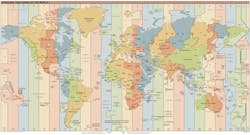A Smarter Way to Solve the Daylight Saving and Standard Time Debate
Last year the U.S. Senate passed the “Sunshine Protection Act” to make Daylight Saving Time (DST) permanent, though it hasn’t passed the House. The major alternatives considered were making Standard Time (ST) permanent or keeping the status-quo transition between the two types of timekeeping.
The annual switch has significant benefits: minimizing dark winter mornings during ST while extending usable daylight and potentially saving energy during DST. Claimed energy savings was the major reason Congress mandated DST in both world wars. From WWII to 1966, states had control of DST, after which Congress created a Uniform Time Act across all states.
A major rationale for eliminating the annual switch to DST is that, like jet lag, the switch results in sleep loss for up to two weeks, producing ill effects, including reduced work and school performance, and more strokes, heart attacks, and car crashes.
“Smart technology can eliminate the gap between man-made and biological clocks. Your smartphone can already automatically change its clock to adjust for standard vs. DST and time zone changes. But this grossly underutilizes its capacity to align man-made and biological clocks.”
Keeping one time all year is no panacea either. Year-round ST means dark, depressing winter afternoons; year-round DST means dark, dangerous morning commutes and increased risk of circadian (body clock) misalignment—particularly for those with little control over daily schedules.
None of the current proposals addressing the clock-change challenge adequately addresses these problems. We propose a radically different approach using technology to optimize health and safety by avoiding abrupt transitions and better aligning man-made clocks with human biology.
Humans evolved to survive without man-made clocks. They tended to wake at sunrise and sleep after sunset. They thus followed circadian (“biological”) clocks attuned with this “solar clock” rather than man-made clocks.
The improved coordination made possible by man-made clocks greatly contributed to the development of modern civilization, including the Industrial Revolution. But syncing man-made and biological clocks has been an ongoing technological and institutional challenge.
“We might also consider unlocking ourselves from fixed schedules with seasonal adjustments to school and work hours and flex-time policies that better align our schedules to our biology.”
The basic coordination problem has been that dawn and dusk—and thus duration of sunlight—change incrementally day by day. For example, 8:30 am might be bright daylight during early summer (the longest days of the year) and pitch black during early winter (the shortest days). In Maryland, where we live, the amount of daylight varies by roughly five hours over the year.
Changing clocks by one hour as seasons change has helped alleviate this problem. For example, in Maryland changing clocks means the sun is shining at 8:30 am all 12 months.
But it’s not an ideal solution. The actual light change during a year is much greater than one hour. And any abrupt change in man-made clocks conflicts with the gradual change in daylight that our biological clocks evolved to accommodate. Even the current one-hour jump, modest as it is, harms the human body.
“Smart” technology can eliminate the gap between man-made and biological clocks. Your smartphone can already automatically change its clock to adjust for standard vs. DST and time zone changes. But this grossly underutilizes its capacity to align man-made and biological clocks.
Ideally, we would align the two types of clocks more closely by resetting them by under a minute every day rather than the current hour change at months-long intervals. This automatic and incremental realignment could be done at 2 am just like the existing ST-DST transition. This strategy offers the advantages of both ST and DST without a disruptive transition. We could even choose to increase adjustments to reflect actual changes in daylight rather than the current arbitrary one hour.
Many personal computers, smartphones, smartwatches, cars, trains, boats, airplanes, and other Internet-connected devices already have the built-in technology to make such automatic changes. With the rollout of the new Internet-of-things standard (“Matter”), the number of smart timekeeping devices is expected to explode.
To be sure, such a change, like the transition to green energy, could not happen overnight. It would take over a decade of planning, if only because billions of legacy “dumb” clocks would be made obsolete by such a change, not to mention serious disparities for people without access to smart technologies. But the long-term payoff in greater human health and economic efficiency makes it a worthwhile goal.
We might also consider unlocking ourselves from fixed schedules with seasonal adjustments to school and work hours and flex-time policies that better align our schedules to our biology. Such “unlocking” will be essential, in fact, if we move away from local timekeeping and adopt Coordinated Universal Time (UTC), where everyone’s clock is set to an identical time regardless of location. Already used for certain applications such as aviation and military coordination, UTC is also a more practical approach to time in places outside of the earth’s populated latitudes (e.g., on the earth’s poles and in outer space).
However, adopting UTC is even more culturally disruptive than adopting a smart-clock approach because it requires a paradigm change: instead of the current “local-time” paradigm where “12 pm” coincides with noon wherever you are on earth, suddenly the time we now call “12 pm” could coincide with sunrise, noon, or sunset depending on location. If we insisted on a 9-5 workday globally, some people would be opening their shops in the middle of the night. With UTC, it would thus make more sense to start work or school an hour or two after sunrise, regardless of the number on the universal clock.
However radical these scenarios may sound, it’s worth considering how recently, and frequently, complex modern cultures have changed time systems. Neither a standard time nor time zones existed until the mid-19th century, when the pressing need to coordinate rail schedules led to a system of standardized time. And DST wasn’t created until World War I, when Germany first adopted it to save money on energy costs.
"To be sure, such a change, like the transition to green energy, could not happen overnight. It would take over a decade of planning, if only because billions of legacy 'dumb' clocks would be made obsolete by such a change, not to mention serious disparities for people without access to smart technologies."
The future may ultimately belong to a universal time system, just as most humans may one day live outside planet earth. So long as local time systems continue to reign, however, our priority should be exploiting emerging smart-clock technology, which can not only automatically translate among different time systems but make whatever local time systems we choose better align with our biological clocks.
About the Author

J.H. Snider, PhD
President of iSolon.org
Dr. Snider is the President of iSolon.org, a nonprofit focusing on using new technology to solve the most difficult public policy problems. He has 30 years of experience in public policy at the local, state, and federal levels of government. For more information, visit isolon.org.
Terra Ziporyn, PhD
Co-Founder and Executive Director of Start School Later
Dr. Ziporyn is Co-Founder and Executive Director of Start School Later, a nonprofit working to ensure school hours are compatible with health, safety, and equity. An award-winning science writer, her books include The New Harvard Guide to Women’s Health, Nameless Diseases, and Future Shop (co-authored with J.H. Snider). She can be reached via email [email protected] or visit www.startschoollater.net. You can also follow her on Twitter: https://twitter.com/terraziporyn.


